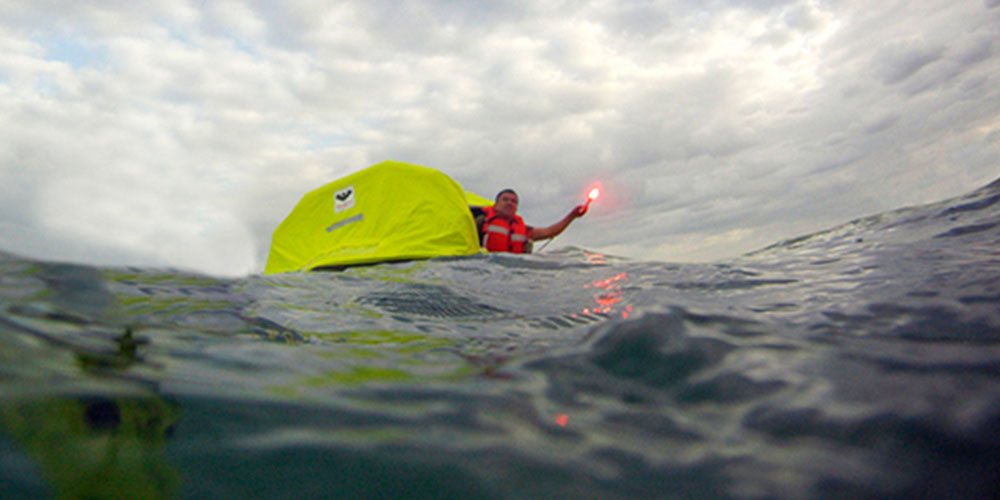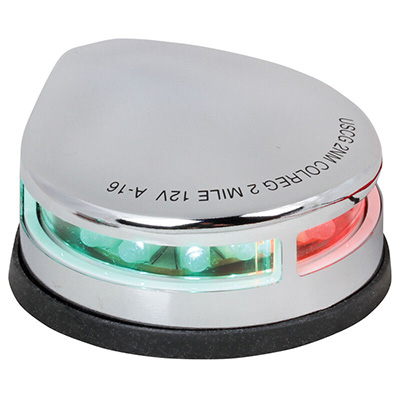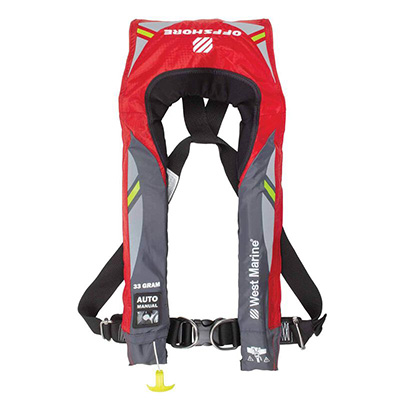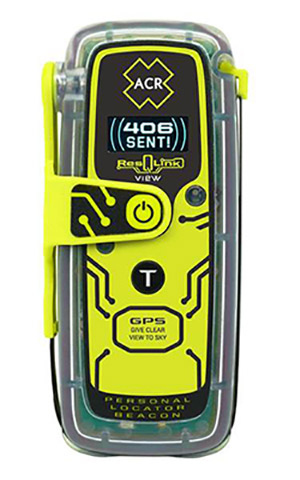
U.S. Coast Guard regulations are designed to keep you safe on the water. The safety gear that you are required to carry depends on the size of your vessel. This article outlines exactly what you need to meet the Coast Guard requirements. Find the range that your boat belongs to below to determine what safety gear you need to carry. Keep in mind that these are minimum requirements. We'll discuss extra safety measures later on that you can take to keep yourself and your crew safe on the water.
- Safety Gear Requirements by Vessel Size
- Navigating After Sunset
- PFDs Save Lives
- Emergency Communcation
- Equip for the Conditions
- Safety Equipment FAQs
New boats normally include the gear you need to meet minimum U.S. Coast Guard requirements. This includes safety gear, a sanitation device, required waste, oil and garbage placards and other items. While you’re newly commissioned boat might be legally ready for service, we recommend having some additional gear before you cast off.
Emergency Cutoff Switches
As of April 1, 2021, operators of boats less than 26 long are (in most cases) required to make use of an emergency cuttoff switch (ECOS) device. For an explanation of this law, see Get Connected—It's the Law!
Canoes and Kayaks Less than 16'
- Personal Flotation Devices: One Type I, II, III or V per person. PFDs must be Coast Guard approved, wearable by the intended user and readily accessible. (See "Type versus level" section below.)
- Visual Distress Signals: Night signals required when operating at night; date of manufacture must be within 42 months of the current date.
- Sound Producing Devices: Horn or whistle recommended to signal intentions or signal position.
Vessels Less than 16'
- Personal Flotation Devices One Type I, II, III or V per person. PFDs must be Coast Guard approved, wearable by the inteded user and readily accessible. (See "Type versus level" section below.)
- Fire Extinguishers: One B-I, any type. Fire extinguishers required on boats with enclosed engine compartments (not outboards), enclosed living spaces or permanent fuel tanks.
- Visual Distress Signals: Night signals required when operating at night; date of manufacture must be within 42 months of the current date.
- Sound Producing Devices: Horn or whistle recommended to signal intentions or signal position.
- Marine Sanitation Devices:Vessels with installed toilet facilities must have an operable, Coast Guard-certified Type I, II or III Device (MSD). Subject to local laws.
- Pollution Regulation Placards: No placards required.
- Backfire Flame Arrestor: One Coast Guard-approved device on each carburetor of all gasoline-powered engines built after August 1980, except outboard motors.
- Ventilation: Coast Guard-standard system required on gasoline-powered vessels with enclosed engine compartments built after August 1980.
Vessels 16' to Less than 26'(8m)
- Personal Flotation Devices: One Type I, II, III or V per person plus one Type IV throwable. PFDs must be Coast Guard approved, wearable by the intended user and readily accessible. (See "Type versus level" section below.)
- Fire Extinguishers: One B-I, any type. Fire extinguishers required on boats with enclosed engine compartments (not outboards), enclosed living spaces or permanent fuel tanks.
- Visual Distress Signals: Minimum of three-day use and three-night use or three day/night combination pyrotechnic devices. Non-pyrotechnic substitutes: one orange distress flag (day-use) and one electric SOS signal light (night-use). Pyrotechnic signals must be have a manufacture date within 42 months of the current date.
- Sound Producing Devices: Horn or whistle recommended to signal intentions or signal position.
- Marine Sanitation Devices: Vessels with installed toilet facilities must have an operable, Coast Guard-certified Type I, II or III Marine Sanitation Device (MSD). Subject to local laws.
- Pollution Regulation Placards: No placards required.
- Backfire Flame Arrestor: One Coast Guard-approved device on each carburetor of all gasoline-powered engines built after August 1980, except outboard motors.
- Ventilation: Coast Guard-standard system required on gasoline-powered vessels with enclosed engine compartments built after August 1980.
Vessels 26' to Less than 40'(12m)
- Personal Flotation Devices: One Type I, II, III or V per person plus one Type IV throwable. PFDs must be Coast Guard approved, wearable by the intended user and readily accessible. (See "Type versus level" section below.)
- Fire Extinguishers: One B-II or two B-I
- Visual Distress Signals: Minimum of three-day use and three-night use or three day/night combination pyrotechnic devices. Non-pyrotechnic substitutes: one orange distress flag (day-use) and one electric SOS signal light (night-use). Pyrotechnic signals must be have a manufacture date within 42 months of the current date.
- Sound Producing Devices: Horn or whistle required to signal intentions or signal position.
- Marine Sanitation Devices: Vessels with installed toilet facilities must have an operable, Coast Guard-certified Type I, II or III Marine Sanitation Device (MSD). Subject to local laws.
- Pollution Regulation Placards: 5" x 8" Oil Discharge placard and 4" x 9" Waste Discharge placard.
- Backfire Flame Arrestor: One Coast Guard-approved device on each carburetor of all gasoline-powered engines built after August 1980, except outboard motors.
- Ventilation: Coast Guard-standard system required on gasoline-powered vessels with enclosed engine compartments built after August 1980.
Vessels 40' to Less than 65'(20m)
- Personal Flotation Devices: One Type I, II, III or V per person plus one Type IV throwable. PFDs must be Coast Guard approved, wearable by the intended user and readily accessible. (See "Type versus level" section below.)
- Fire Extinguishers: One B-II and one B-I, or three B-I
- Visual Distress Signals: Minimum of three-day use and three-night use or three day/night combination pyrotechnic devices. Non-pyrotechnic substitutes: one orange distress flag (day-use) and one electric SOS signal light (night-use). Pyrotechnic signals must be have a manufacture date within 42 months of the current date.
- Sound Producing Devices: Horn or whistle required to signal intentions or position.
- Marine Sanitation Devices: Vessels with installed toilet facilities must have an operable, Coast Guard-certified Type I, II or III Marine Sanitation Device (MSD). Subject to local laws.
- Pollution Regulation Placards: 5" x 8" Oil Discharge placard and 4" x 9" Waste Discharge placard. Vessels 40' and longer with a galley must have a Waste Management Plan.
- Backfire Flame Arrestor: One Coast Guard-approved device on each carburetor of all gasoline-powered engines built after August 1980, except outboard motors.
- Ventilation: Coast Guard-standard system required on gasoline-powered vessels with enclosed engine compartments built after August 1980.
- A copy of the Inland Navigation Rules (Rules of the Road) must be kept on board.
Vessels 65' to Less than 165'(50m)
- Personal Flotation Devices: One Type I, II, III or V per person plus one Type IV throwable. PFDs must be Coast Guard approved, wearable by the intended user and readily accessible. (See "Type versus level" section below.)
- Fire Extinguishers: Vessels weighing up to 50 gross tons must carry at least one B-II extinguisher. Vessels weighing 50 to 100 gross tons must carry two B-II extinguishers.
- Visual Distress Signals: Minimum of three-day use and three-night use or three day/night combination pyrotechnic devices. Non-pyrotechnic substitutes: one orange distress flag (day-use) and one electric SOS signal light (night-use). Pyrotechnic signals must be have a manufacture date within 42 months of the current date.
- Sound Producing Devices: One bell and one whistle or horn required to signal intentions or position.
- Marine Sanitation Devices: Type II or III MSD only.
- Pollution Regulation Placards: 5" x 8" Oil Discharge placard and 4" x 9" Waste Discharge placard. Vessels 40' and longer with a galley must have a Waste Management Plan
- Backfire Flame Arrestor: One Coast Guard-approved device on each carburetor of all gasoline-powered engines built after August 1980, except outboard motors.
- Ventilation: Coast Guard-standard system required on gasoline-powered vessels with enclosed engine compartments built after August 1980.
- A copy of the Inland Navigation Rules (Rules of the Road) must be kept on board.
USCG Old “Type” versus New “Level” Life Jacket Labeling
In the 1980s the U.S. Coast Guard created four “Type” ratings for life jackets plus one “Type” rating for throwable flotation. These ratings correspond to wearable flotation labeled as Type I, II, III and V and throwable flotation labeled as Type IV. In 2014, with the intent of “harmonizing” life jacket standards between the United States and Canada, the Coast Guard announced that beginning in 2016, “Type” ratings were to be dropped in favor of a system of “Level” ratings. For recreational life jackets and throwable flotation, these ratings correspond to Levels 50, 70, 100 and 150.
The “harmonized” standards described above have been slow to take hold. As of May of 2024, the only recreational flotation sold in the United States that is affected by the harmonized standards are Type II life jackets for infants and Type III life jackets for children, youth and adults which have been relabeled as “Level 70”. Other USCG type-labeled flotation is not affected. Does this mean that you will need to trade in your existing Type III life jackets for Level 70 models? The answer is no, as long as your Type III life jackets are in serviceable condition. For more about life jacket labeling and “Level” performance ratings, see the Harmonized Life Jacket Approvels pdf kindly supplied to West Marine by the Kent Sporting Goods Company. For a comprehensive discussion and a video on how to select life jackets that are right for you and your crew, see our West Advisor article How to Select a Life Vest.
Navigate Safely After Sunset

Vessels operating on the water after sunset are required to run navigation lights to avoid collisions with other boats.
If you're on the water after dark you will need navigation lights to legally and safely operate your boat. The lights that you need depends on the size of your vessel and our West Advisor Article on Navigation Light Rules will tell you what lights you need.
The Rest of the Gear We Recommend
The lists above will satisfy minimum requirements for operating your boat, but there are other saftey products that have proven their worth when the worst happens on the water. While these products will require a little more investment on your part, they are an investment in the safety of yourself and others on your boat. At West Marine, we are commited to making life on the water as enjoyable as possible and having the right safety gear is part of that.
PFDs Save Lives

Our All Clear® Offshore Inflatable PFD features automatic or manual inflation and includes a harness for clipping into jacklines.
In 2017, the Coast Guard counted 4,291 accidents that involved 658 deaths, 2,629 injuries and approximately $46 million dollars of damage to property as a result of recreational boating accidents. In 76 percent of fatal boating accidents the victims drowned. Of those who drowned in 2017, 84 percent were not wearing a life jacket. In most states children are required to wear a personal flotation device (PFD), but adults can use their discretion, and many boaters choose to leave the PFD sitting in a locker. If your boat is hit by a wave or collides with another boat and you are knocked overboard whatever safety gear you are currently wearing is all you will have and your PFD will remain secure on the boat while you struggle to stay afloat.
The solution? Invest in a comfortable PFD appropriate for your type of boating and wear it every day. We carry an extensive selection of PFDs including inflatable life jackets which are unobtrusive until you need them. Lower priced models like the West Marine Inshore PFDs are available with 25.5lb. of buoyancy, instead of the 35lb. coastal or offshore versions. These streamlined, lightweight vests don't inhibit your movement and are perfect for inshore boating on lakes and rivers. They are available in automatic, manual and manual beltpack activation.
Throwable PFDs that Double as Rescue Slings

Lifesling2 is the most widely-accepted method to get an overboard crew member back aboard your boat.
Hoisting overboard crew members back on board is challenging even in the best conditions. Extensive testing of crew overboard recovery gear in San Francisco Bay produced a clear consensus that one product, the Lifesling, is a great device for getting a person back to the boat and aboard safely. The Lifesling2 includes a flotation collar (a hybrid of a traditional horseshoe buoy and a helicopter rescue sling) with 125' of floating retrieving line. It can be towed to the victim so they do not need to swim after it and then used as a lifting sling (using a separate hoisting tackle). The Lifesling Inflatable combines these capabilities with the compactness and throwability of a rescue throw rope bag, inflating instantly on hitting the water.
Emergency Communication
33 percent of the boats that request a free safety inspection from the Coast Guard Auxilary do not have a VHF radio. A VHF radio is a key safety item that all boaters should carry for routine communication with other boats and digital selective calling for an emergency. DSC is like 911 for your boat—better in fact, because rescuers have the technology to determine exactly who and where you are, and sometimes the exact nature of your emergency. But to make DSC work, boaters need three things: a DSC-equipped VHF, a connection to a GPS receiver (to pinpoint your position so rescuers can find you), and to register for a free MMSI Number (so they know who you are). Push one red button on your radio, and it automatically sends a distress message to everyone within radio range. For more information on how VHF radios help in an emergency read our West Advisor Article on Making a Mayday Call on Your VHF Radio.
An emergency position indicator radio beacon (EPIRB) or a personal locator beacon (PLB) is an excellent addition to your safety gear and will make it much easier for rescue crews to find you in an emergency. EPIRBs and PLBs are able to transmit your location and your identity to rescue teams from anywhere on the globe and are free to use once you purchase the unit. Our West Advisor article on Selecting an Emergency Beacon has all the information you need for choosing which is right for you and your crew.
Equip for the Conditions

The ResQLink View Buoyant Personal Locator Beacon has a small digital display that confirms that your message has sent and will display your GPS coordinates in case you need to provide your location to search and rescue personnel over a VHF radio.
You can never be too prepared for an emergency and you should consider the specific conditions you may encounter before you head out on your voyage including:
Water temperature: Few environments in the world are as dangerous to humans as cold water. If you operate your boat in the Pacific Northwest, the Great Lakes or in other cold-water regions, bring gear that protects you and your crew from hypothermia.
Poor visibility: High quality navigation lights, sound signals and radar units can lessen the danger of low visibility conditions like fog or rainsqualls.
Distance from help: If your cruising route includes the coast of Mexico, Bermuda or a trip to Hawaii, you'll be far from the convenience of your local boating supply store and far from the security of the US Coast Guard. The need to be self-sufficient is greatly increased away from inland and coastal US waters.
Rapidly changing weather conditions: Many boating areas are subject to squalls or other fast moving weather systems that can stir up trouble in a hurry. Boats operating in these areas should have gear aboard which can be used defensively, like larger anchors, lightning detectors and grounds, mainsail reefing equipment, drogues and sea anchors.
Rough seas: Many areas, like San Francisco Bay in the summer, have consistently strong winds and heavy chop. That makes for great sailing, but also raises equipment requirements for sailboats and powerboats alike.
For More Information:
For Federal requirements and safety tips, see A Boater's Guide to the Federal Requirements for Recreational Boats.
Safety Equipment FAQs
What are the basic U.S. Coast Guard safety equipment requirements for recreational vessels?
The Coast Guard requires specific safety equipment based on vessel size, including personal flotation devices (PFDs), visual distress signals, sound-producing devices, and fire extinguishers. Boats with certain facilities or engine types may have additional requirements.
How do I determine which safety gear my boat needs?
Refer to the section in the article that matches your vessel’s size range. Each category lists the minimum requirements specific to that boat size, along with recommended additional items.
What are the new regulations regarding emergency cutoff switches?
As of April 1, 2021, operators of boats under 26 feet in most cases must use an emergency cutoff switch (ECOS) while the vessel is underway, helping to prevent runaway vessels in case the operator falls overboard.
Are navigation lights required if I’m only boating during the day?
Navigation lights are required only when operating after sunset. However, having functioning navigation lights onboard is recommended as weather conditions can affect visibility unexpectedly.
What is the difference between Type-rated and Level-rated life jackets?
Life jacket labeling is in the process of transitioning from Type ratings (I, II, III, IV, and V) to Level ratings (50, 70, 100, and 150) to align with international standards. Life jackets labeled as "Level 70" are currently replacing Type III jackets — but existing Type-rated jackets can still be used if they’re in servicable condition.
Do I need a VHF radio onboard?
Although not required by the United States Coast Guard, a VHF radio is highly recommended for emergency communication, which includes making a mayday call on channel 16 if you find yourself in distressl. VHF radios that are equipped with Digital Selective Calling (DSC) and GPS give you the ability to broadcast a distress signal with your location to other vessels and authorities.
What additional equipment should I consider for emergency preparedness?
In addition to Coast Guard-required gear, consider carrying items like an EPIRB or PLB to summon aid in an emergency, We also suggest you carry a few extra PFDs, a first aid kit and a Lifesling for man-overboard recovery.









